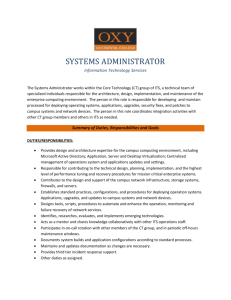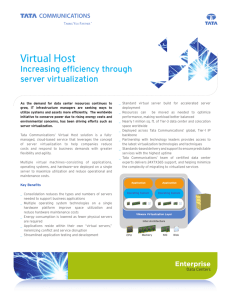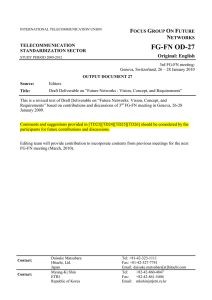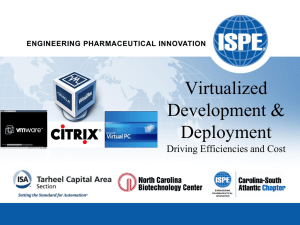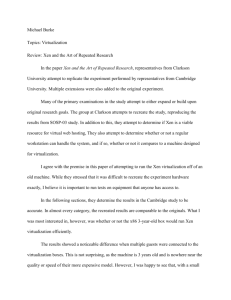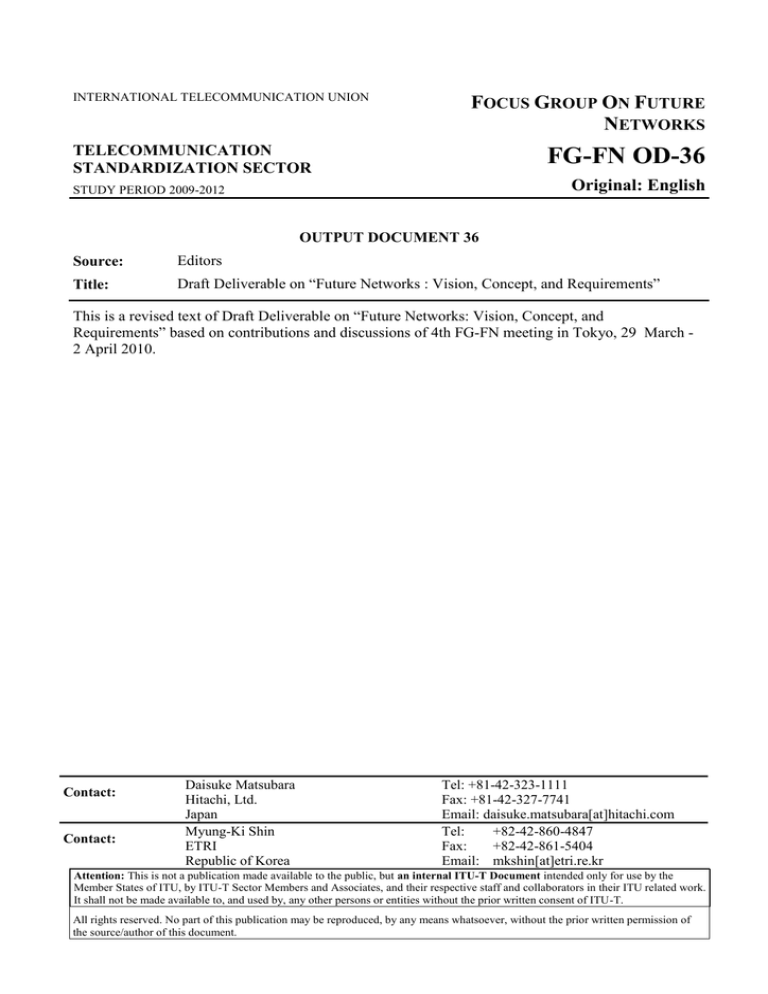
INTERNATIONAL TELECOMMUNICATION UNION
FOCUS GROUP ON FUTURE
NETWORKS
TELECOMMUNICATION
STANDARDIZATION SECTOR
FG-FN OD-36
Original: English
STUDY PERIOD 2009-2012
OUTPUT DOCUMENT 36
Source:
Editors
Title:
Draft Deliverable on “Future Networks : Vision, Concept, and Requirements”
This is a revised text of Draft Deliverable on “Future Networks: Vision, Concept, and
Requirements” based on contributions and discussions of 4th FG-FN meeting in Tokyo, 29 March 2 April 2010.
Contact:
Contact:
Daisuke Matsubara
Hitachi, Ltd.
Japan
Myung-Ki Shin
ETRI
Republic of Korea
Tel: +81-42-323-1111
Fax: +81-42-327-7741
Email: daisuke.matsubara[at]hitachi.com
Tel:
+82-42-860-4847
Fax:
+82-42-861-5404
Email: mkshin[at]etri.re.kr
Attention: This is not a publication made available to the public, but an internal ITU-T Document intended only for use by the
Member States of ITU, by ITU-T Sector Members and Associates, and their respective staff and collaborators in their ITU related work.
It shall not be made available to, and used by, any other persons or entities without the prior written consent of ITU-T.
All rights reserved. No part of this publication may be reproduced, by any means whatsoever, without the prior written permission of
the source/author of this document.
-2FG-FN OD-36
Future Networks : Vision and Concept
Summary
This document describes the motivation, vision, design goals, and concept of Future Networks.
Table of Contents
1. Scope
2. Definition
3. Introduction
4. Motivation of Future Networks
5. Vision
6. Design Goals
7. Concept
7.1 Network Virtualization
7.2 In-system Network Management
7.3 Energy Saving of Networks
7.4 Identification
7.5 Mobility
7.6 Self-optimization Network
Bibliography
-3FG-FN OD-36
Future Networks: Vision, Concept, and Requirements
1. Scope
This document describes the motivation, vision, and concept for Future Networks.
The scope of this deliverable includes:
Motivation and Vision of Future Networks
Design goals of Future Networks
Concept of Future Networks
2. Definition
Component network: A component network consists of a single homogeneous network, which by
itself does not provide a single seamless end-to-end global telecommunication infrastructure.
EdNote: Is clarification of “sing seamless” may be needed.
Federation: Federation is a technology that enables a heterogeneous collection of component
networks to be operated as a single seamless network that shares network resources with other
networks, while the networks are geographically dispersed and managed by different providers.
Note: A federation of networks is sometimes known as a “network of networks”.
Future Network (FN): A future network is a network which is able to provide revolutionary
services, capabilities, and facilities that are hard to provide using existing network technologies.
A future network is either:
a) a new component network or an enhancement to an existing one;
or
b) a federation of new component networks or federation of new and existing component networks.
Notes:
1 A network of type b) may also include networks of type a).
2 The label assigned to the final federation may or may not include the word “future” depending
on its nature relative to any preceding network and similarities thereto.
Future Networks (FNs): Future Networks is a plurality of Future Network. It is usually used to
express that there may be more than one network that fits in the definition of “Future Network”,
New: In the context of this document the word “new” component network means that the
component network is able to provide revolutionary services, capabilities, and facilities that are
difficult or impossible to provide using existing network technologies.
EdNote: The texts below are placed to explain fundamental issues regarding FN.
FN is still in the early R&D stage, and there is no concrete specification or enabling technology to
accommodate FN’s vision. Therefore, gap analysis between current networks and FN cannot be conducted at
-4FG-FN OD-36
this time. This document will be revisited when details of the technology is fully developed, to conduct
thorough gap analysis.
It should be noted that FN can be based on IP technology or technology other than IP.
3. Introduction
Internet Protocol (IP) technology, and networks based on IP technology has shown enormous
flexibility to meet users’ ever-changing requirements. It was first designed for text-based computer
networks, and first applications of the Internet were delay-tolerant ones such as FTP or email. It
then started to realize real-time applications such as VoIP and IPTV, applications that requires large
bandwidth and/or low latency.
On the other hand, network layer technology, or functions that realizes global interconnectivity, is
very difficult to change because its change affects anything connected the network. It is not known
if IP, and networks based on IP, will continue to satisfy requirements of future society. Research
communities are preparing for the day when IP and IP-based networks becomes insufficient by
investigating various technologies such as network virtualization, energy saving networks, datacentric network, etc. Considering that some technologies are carefully designed to minimize the
migration cost from traditional IP networks, the day that these technologies will be essential may
not be unimaginably far away.
EdNote: data-centric is not mentioned in the later section. Contribution necessary.
Today, new requirements are emerging, such as sustainability, lower burden of operation and
management, and Machine-to-Machine communications. Huge demand and market like this may
have the potential to finance the enormous investment required to change large-scale
telecommunication networks. Considering the wide variety of new requirements or new priority of
requirements, it seems reasonable to expect that some requirements can be realized by new network
architecture based on the ongoing research activities for the day, and to expect that such new
architecture could be the foundation of networks of the future, which the prototyping and phased
deployment may fall roughly between 2015 and 2020. We call networks based on such new
architecture Future Networks, and this document therefore investigates motivations, visions and
concepts of future networks that arise from new social requirements.
4. Motivation of Future Networks
EdNote: This section explains "why" we need to do research and standardization. This includes
problems in the current Internet.
EdNote: This description, IP is in “crisis”, which contradicts with the introduction. These need to be
aligned.
The remarkable advances in network technology in recent years have brought about a new
information revolution that ranks alongside the industrial revolution. Today, network is an essential
part of our social infrastructure not only in the business world but also in our everyday social lives.
The current networks (e.g. Internet), however, is facing a critical crisis. The thin veneer of
expansion of the network has come off, and the network finds it difficult to respond to newly
emerging social demands. And the current networks show a level of inflexibility at the network
layer and a lack of built-in facilities to support any non-basic functionality.
-5FG-FN OD-36
Areas for substantial improvement beyond what the current networks can provide include are:
EdNote: Contributions to refine these problem statements are needed.
• Facilities for the addition of new functionality, including capability for activating a new service
on-demand, network functionality, or protocol (i.e. addressing the ossification bottleneck). (EdNote:
relates to 6.1 Network Virtualization)
•
Inherent network management functionality, specifically self-management functionality.
(EdNote: relates to 6.2 In-service Network Management)
• Cost considerations – the overhead of management should be kept under control since this is a
critical part of life-cycle costs. (EdNote: relates to 6.2 In-service Network Management)
• Facilities for the large scale provisioning and deployment of both services and management;
support for higher integration between services and networks. (EdNote: relates to 6.2 In-service
Network Management)
• Energy awareness. (EdNote: relates to 6.3 Energy Saving Network)
• An adequate addressing scheme, where identity and location are not embedded in the same
address. (EdNote: relates to 6.4 Identification Management)
• Mobility of networks, services, and devices. (EdNote: relates to 6.5 Mobility)
EdNote: We need to add problem statement for 6.6 concept.
EdNote: The problems below are candidates for “low priority” problems, or candidates for deletion.
These problems must be defined in more detail to clarify what are the problems that cannot be
easily solved by current networks, such as NGN. If no contribution is submitted to improve each
sentence by next meeting (5th FG-FN), the sentence should be removed.
• Guaranteeing availability of service according to Service Level Agreements (SLAs) and
highlevel objectives.
• Facilities to support Quality of Service (QoS) and Service Level Agreements (SLAs).
• Support of security, reliability, robustness, mobility, context, service support, orchestration and
management for both the communication resources and the services’ resources.
• Support of socio-economic aspects including the need for appropriate incentives, diverse
business models, legal, regulative and governance issues.
• Trust Management and Security; Privacy and data-protection mechanisms of distributed data.
• Support solution for the tussles over the internet with economic incentives, Future Network
fulfils diverse participants of the Internet. Each participant of the Internet vies in favour of their
particular interests. For example, users, commercial ISPs, governments, intellectual property right
holders, and/or content/high-level-service providers are parts of the Internet and have their own
particular interests.”
There may be possibility that some of these problems will be solved by enhancing the current
network. However it is most likely that these problems will be extremely difficult or impossible to
achieve by just enhancing the current network. Therefore, Future Networks that can overcome these
problems and complement the several missing aspects of the current networks must be developed.
-6FG-FN OD-36
EdNote: The text above is vague. Refinement will be provided.
-7FG-FN OD-36
5. Vision
5.1 Target Date
The estimated target date for prototyping and phased deployment of Future Networks should
roughly fall between 2015 and 2020. This estimate is based on two factors: First, the status of
current and evolving technologies that would be employed in the experimentation and development
of FNs. Second, any novel development that might take place well beyond that estimate is too
speculative and is outside the mandate of this document.
Any global multi-service infrastructure comprises a number of networks and network technologies
arranged in various vertical (stacked) and horizontal (peered) combinations.
The nature of such a federated network implies a mixture of networks at different stages of
evolution. Some existing components may be replaced by a new network technology, some may be
enhanced by a future technique, and completely new ones may be added. Additionally, the network
components will vary dynamically from one telecommunication instance to another depending on
the service under consideration, features invoked and related routing choices.
Various evolution and migration strategies may be employed to accommodate emerging and future
network technologies. Each case will be to be examined on its merits and its relation to the role
played by the network technology under consideration as part of the future global infrastructure.
Appropriate usage scenarios and deployment cases will need to be considered when the research has
been completed for the area(s) under consideration, and appropriate conclusions reached and
agreed.
5.2 Vision
For the Future Networks to be a part of essential social infrastructure, the Future Networks should
be researched and developed with consideration to following three points of view: Network for/of
Individual, Network for/of Society and Network for/ on Earth.
EdNote: Contribution for refining the text below will be provided in next meeting.
Network for/of Individual
The future network should empower human ability and potential. For this, every user of future
network should be able to access it easily and get customized services for his/her needs. The future
network also should also be used for augmenting human memory and ability.
Network for/of Society
The future networks should become the common and global information exchange of human
knowledge and should be scalable to provide cultural, scientific and technological exchange among
different regions and cultures. At the same time, the future network must be secure, accountable,
and reliable without impeding user privacy, dignity, and selfarbitration.
-8FG-FN OD-36
Network for/ on Earth.
The future network should help to solve earth scale issues such as climate change and energy
conservation, and at the same time, the network itself must be environmentally friendly and
energetically sustainable.
6. Design Goals
EdNote: “Design goals” are capabilities that should be supported by Future Networks.
Future Network design goals can be discussed from the four kinds of view: service view, social
view, commercial view, and operation and management view.
6.1 Service View
From service view, FN will needs to satisfy an extremely wide range of customer demands. FN
should:
be programmable network architecture that can implement any service network. This service
network is demanded by diverse users. Therefore Future Network forms a network of networks,
i.e., meta-network architecture.
support bandwidths ranging from narrow ones to ultra-wide ones.
support wide dynamic range of latency for adapting applications and services characteristics
accommodate a huge number and wide variety of terminal devices.
provide applications and services which does not depend on user devices and terminals.
provide the network services with high reliability
support flexible mobility to achieve ubiquitous / pervasive communication environment.
be equipped with advanced security mechanisms against DDoS attacks, tapping, impersonation,
etc.
be able to manage digital assets such as digital content copyrights.
6.2 Social View
EdNote: this section may be more suitable for vision section because this is social issue.
From the social view, Future Network is new paradigm of future social infrastructure that enables
social growth and environmental conservation. FN should:
support public and/or private social applications such as collaboration, transportation, healthcare, and so on.
provide services that contribute to environmental conservation.
be designed while carefully considering power consumption incorporating device, system,
provisioning, operations, and management aspects.
6.3 Commercial View
-9FG-FN OD-36
In Future Network, each participant is technically guaranteed proper economic incentives according
to their contribution, thus the tussle is resolved
EdNote: Economic issues are out of scope of this document. Additional bullet items are needed to
explain the details of commercial view.
6.4 Operation and Management View
From the operation and management view, Future Network should solve complexity of operation
and management. FN should:
enable smooth migration between different network services
be able to accommodating both in-service and experimental technologies.
have the capacity to support and sustain new technologies.
be able to be deployed flexibly.
support effective utilization networked ICT resources according to changes in demand
support network and service management automation such as self-stabilization and selfmanagement functions etc.
be able to provide customized service for individual customers based on their context
take customer QoE(Quality of Experience) into consideration besides QoS
provide user-oriented service platforms that create new businesses
be able to acquire accurate and real-time information of network and service resource status
and health
support simple but flexible knowledge representation of network and service management
information
be able to acquire complete, consistent, unambiguous, correlated and filtered management data
support statistical intelligent learning mechanisms to process massive management data and
information
support easy, robust, secure, reliable and predictable network and service resource control
support false-positive and negative free fault detection, diagnosis, and isolation of network and
service resources
Support network and service aware management collaboration
EdNote: This list should be trimmed down to less than 10 items to align with other design goals.
7. Concept
EdNote: This section explains ideas or research topics of Future Networks that are important and
may be relevant to future ITU-T standardization.
EdNote: The levels of abstraction/granularity of the concept should be aligned with each FN
technology documents such as “network virtualization” and “energy saving networks.
- 10 FG-FN OD-36
EdNote: The title of concept should be commonly known name of research areas such as “network
virtualization” and should not be particular project name.
EdNote: The description of each concept should be brief, about 1/2 to 1 page. Details of the concept
should be explained in separate documents.
7.1 Network Virtualization
EdNote: Contribution from ETRI, NICT is needed to refine this concept.
The Future Network should provide much better support for a broad range of applications, services,
and network architectures. In the Future Network, multiple isolated logical networks each with
different applications, services, and architectures should share the physical infrastructure and
resources. Network virtualization is the key features to support them, and federation, and network
programmability should be also tightly coupled with it.
Network virtualization is the technology that enables the creation of logically isolated network
partitions over shared physical network infrastructures so that multiple heterogeneous virtual
networks can simultaneously coexist over the shared infrastructures. Also, network virtualization
allows the aggregation of multiple resources and makes the aggregated resources appear as a single
resource [x].
The virtual networks are completed isolated each other, so different virtual networks may use
different protocols and packet formats. When combined with programmability in network elements,
users of virtual networks can program the network elements on any layers from physical layer to
application layer. They can even define new layering architecture without interfering the operation
of other virtual networks. In other words, each virtual network can provide the corresponding user
group with full network services similar to those provided by a traditional non-virtualized network.
The users of virtual networks may not be limited to the users of services or applications, but may
include service providers. For example, a service provider can lease a virtual network and can
provide emerging services or technologies such as cloud computing service, and so on. The service
providers can realize the emerging services as if they own dedicated physical network
infrastructures. In order to facilitate the deployment of network virtualization, it may be necessary
to provide control procedures such as creating virtual networks, monitoring the status of virtual
network, measuring the performance, and so on.
Also, network virtualization can reduce the total cost by sharing network resources. One of
motivation of network virtualization is to achieve better utilization of infrastructures in terms of
reusing a single physical or logical resource for multiple other network instances, or to aggregate
multiples of these resources to obtain more functionality. These resources can be not only network
components, such as routers, switches, hosts, virtual machines, but also service elements, such as,
operation and measurement services, instrumental services, and so on.
Network virtualization on its own is quite a useful technology, but to gain the greatest benefit it will
be better to have a managed virtualization environment. Such management allows better control,
monitoring, and analysis of the virtualized environments.
Future Network is also recommended to support federation and programmability with network
virtualization technology. Federation enables the networks to be operated as being part of a single
network with sharing network resources, even though the networks are geographically dispersed
and managed by different providers. Programmability enables users to dynamically import and reconfigure new invented technologies into virtualized equipments (e.g., routers/switches) in
networks.
- 11 FG-FN OD-36
7.2 In-system Network Management (EdNote: proper title is needed.)
EdNote: Contribution from Alex (/w Takashi, Daisuke) is needed for this subsection.
7.3 Energy Saving of Networks
EdNote: Contributions from Fujitsu, NTT is needed to refine this subsection.
Future Networks should be the network which has high-efficient energy utilization, which is
realized by optimizing for applications and services with various characteristics (bandwidth and
latency and so on) autonomously. Future Network can reduce the network power consumption by
assigning the network resources which optimize applications and services.
7.4 Identification (EdNote: proper title is needed.)
EdNote: Contributions from ETRI is needed to refine this subsection.
According to the emergence of new technologies and new social requirements, future networks are
expected to have quite different features from current networks. Typical example of these new
features are mobile-oriented, participation of device itself, high security, virtualization, energysaving, etc.
However it is noted that current Internet, which is the basic technology for most current networks,
was designed on the assumption of very limited network environments such as fixed-oriented, small
number of networking nodes, trustworthy correspondents, static infrastructure, etc.
Future networks, which will be a future fundamental infrastructure, need to address those new
features in effective manner and those are closely/directly related to lots of technical issues.
Identification (or identifier) can be seen as the most basic one among them.
It is being reported that current Internet identification has many problem due to its simple
assumption. A typical example is the problem in the point of view of mobile environment.
It is generally envisioned that mobile will be dominant in future network as we can see in the
visions of many worldwide future Internet activities.
7.5 Mobility (EdNote: Proper title is needed)
EdNote: Contribution from KDDI is needed to refine this subsection to refine and generalize the
text.
EdNote: These requirements are derived from “Minimum Core” concept. Generalization of these
requirements may be needed to fit.
The Future Networks should support localization and optimization of the signaling and data
paths.
The Future Networks should enable the network administrator to control the signaling and
data path
The Future Networks should be able to locate the functional entities (e.g., mobility
management) anywhere in the network (both in the mobile core and access networks).
The Future Networks should be able to provide the discovery function (network resources
and devices) of the connected devices in both centralized and distributed fashions.
- 12 FG-FN OD-36
The Future Networks should be able to connect devices that are not fully capable of
mobility and/or security without degradation of those features.
Mobility between virtualized networks
EdNote: These requirements are derived from “Mobility between virtualized networks” capability.
Generalization of these requirements may be needed.
The Future Networks should be able to support for the user to move from one virtualized
network (or LINP) to another.
7.6 Self-optimization Network (EdNote: refinement of this title will be provided in next meeting.)
EdNote: Contribution from NTT is needed to refine this subsection.
Then, Future Networks do not only need flexibilities of physical networks but also flexibilities of
logical networks because several network services are restricted by dependence of physical
networks now. If Future Networks has both flexibilities, several network properties are distributed
anywhere, anytime, everybody and anything to all of this network users (and more). To realize such
a property distributions, Future Networks should have a functional partitioning of network
properties user (and more) required in logical.
Future Networks can exceed or overcome the physical limit which includes such as capacity of
optical fibre, operation frequency of electrical devices and so on, by cooperated with technologies
from devices level (optical and electrical), system level to network architecture level.
• variable bandwidth and latency technology
• NW resource cooperation technology
• traffic centralized/distribution control technology
• electrical/optical optimal function assignment
• hardware/software optimal function assignment
• data format/protocol conversion technology
7.7 Economic incentives
EdNote: KT will contribute for this section
Bibliography
TBD
[1] D. Clark, J. Wroclawski, K. Sollins, and R. Braden, “Tussle in Cyberspace: Defining
Tomorrow’s Internet,” IEEE/ACM Transactions on Networking, Vol. 13, No. 3, June 2005.

